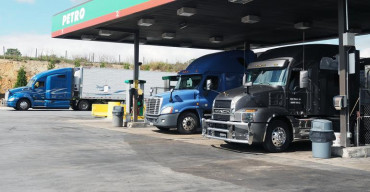Driver wellness: A guide to food and fitness on the road

For you, a truck driver, going to work each day is a lot different than most people. Your office, in the cab of a truck, is almost always in motion. There's hardly any time to relax, and for too many drivers if you aren't working, you aren't getting paid. So staying well is vital.
While having healthy meals at home all the time and going to the gym regularly isn't realistic, there are ways to make sure your body is strong and fit. Here are two short stories, one focusing on nutritional excellence, the other on physical fitness. They can make all those endless hours on the road much easier to handle.
Eating right away from home
This is probably a more regular endeavor for truckers than anyone else. They often eat wherever they happen to be on any given day. How does eating out affect your overall diet? It depends on where you eat, what and how much you order, and what extras you add to the foods you order—dressings, spreads, condiments, and so forth. Of course, how often you eat out is important, too.
When you eat also counts. The typical pattern for many truckers is skipping breakfast, gulping cups of coffee, eating a snack in place of lunch, and finally relaxing at night with a hefty meal. No good. Eating late makes you less hungry in the morning. And while drinking coffee might jolt you awake when you're tired, caffeine is a stimulant for your appetite. It's best to follow the old adage: Eat breakfast like a king, lunch like a prince, and dinner like a pauper.
Where you eat out greatly affects the food choices available to you. For example, a greater selection of menu items gives you the opportunity to choose for variety. And if foods are prepared to order, you can have more control over the calories, fat, sugars, and sodium in your meal.
Here's how eating places compare:
Full-service restaurants usually provide the greatest variety and flexibility in types of foods and preparation methods. Items are often prepared to order, so you can ask that foods be prepared differently than the menu specifies. One drawback of having foods prepared to order is the time it takes. What and how much do you eat while waiting for your order?
Cafeterias, smorgasbords and restaurant buffets also provide a wide variety of food selections. Since foods there are prepared in advance, there's no wait, but you are not able to order foods the way you want them. You do, however, have some control over portion size and the amounts of sauces, gravies, and dressings served with foods. Watch out for "all-you-can-eat" offers, though. You may be tempted to eat too much just to get your money's worth.
Steakhouses generally offer fewer menu items, although different sizes and cuts of meat are often available. Most dishes are prepared to order, but preparation methods may be more limited. Fish and shellfish items are often breaded and fried; broiled and steamed versions are increasingly available. Side dishes usually include items high in fat, like French fries, hush puppies, and creamy coleslaw, for example. Salad bars are sometimes featured.
Pizza parlors offer variety in toppings and crust types but an otherwise limited menu. Toppings vary in calories, fat, and sodium content. Some pizza joints feature salad bars.
Sub shops offer a varied selection of subs and sandwiches but usually little else. Items are prepared to order so the amount of high-calorie, high-fat spreads can be limited. Sometimes smaller servings are available. Many offer a variety of breads.
Fast-food restaurants offer an expanding but still rather limited menu. Many items are deep-fat fried, including chicken and fish items, French fries, onion rings, and fruit pies. However, smaller servings are available for some sandwiches and side orders, and you can request that foods be prepared without sauces or other condiments. Salads, baked potatoes, and whole grain rolls are now available at some fast-food restaurants, and low-fat milk and fruit juices are joining soft drinks and shakes as beverage options. Most fast-food restaurants have caloric information readily available.
Convenience store "mini-meals" and vending machines are a growing source of food eaten away from home. Offerings include chili, hot dogs, nachos with cheese sauce, prepackaged hamburgers and sandwiches, single-serving canned foods, candy, and snack foods. Fat, calories, sugars, and sodium are high in many of these items, especially in processed, prepackaged and canned foods. Some refrigerated vending machines offer alternatives—yogurt, fruit, and fruit juices, for example.
